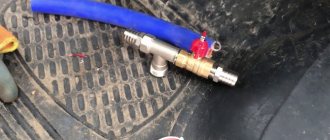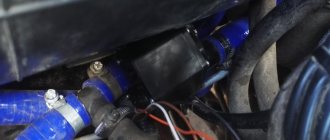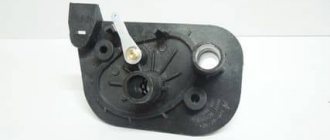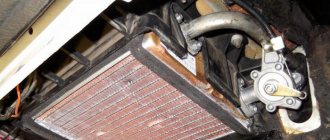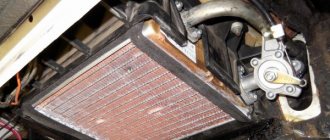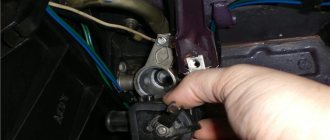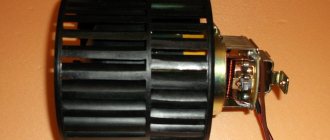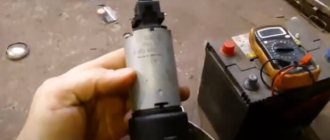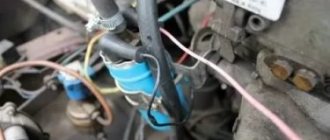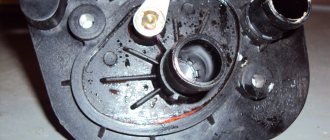The importance and benefits of the interior heating system are felt only in the cold season. When summer comes, the need to use the system disappears. But, as you know, you need to prepare a sleigh in the summer. In the summer, daylight hours are longer, and the weather is conducive to quick and high-quality repairs. First you need to understand how the heating system in a car is designed and functions. On a Gazelle Business car, as on all cars with a liquid-cooled engine, a stove is installed, into which heat is supplied from the heated parts of the engine through coolant. The liquid heats the heater radiator, the fan blows air, which, passing through the honeycombs, heats up and spreads throughout the cabin. Gazelle Business stoves are equipped with an electronic control unit that can control the heater both automatically and manually. To do this, it has a cabin temperature sensor that allows you to maintain the set temperature. All adjustments are electric, and not on cables, as in previous versions. The dampers are controlled by gearmotors, and the temperature is controlled by an electric valve (reducing or increasing the amount of coolant passing through the radiator). All controls are placed on the front panel, which is very convenient and does not distract the driver from driving the car. But any equipment sooner or later malfunctions.
Replacing the faucet of the gazelle business stove
The owner of a long gazelle business came to us from the distant northern Urals, the city of Novy Urengoy, with a complaint about a faulty stove, he says the stove doesn’t heat at all, but he bought this workhorse second-hand the other day and didn’t check the functionality of the stove, so we need to figure out the fault. Errors E3 and E7 (E3 and E7) light up on the display.
And so, we begin the check with a visual inspection of the heater control unit (HCU) 2705-8121020. E3 lights up on the display . Looking ahead, let's say that this malfunction is associated with the heater damper gear motor (90.3780) or MP-2-01 , which is located next to the driver’s right foot under the panel. Looking under the panel and deciding to check whether both connectors were latched, we did not find this gear motor, but only the connectors were dangling. Apparently the previous owner removed the gear motor, but did not install a new one. We install a new gear motor.
Video. Checking the heater damper gear motor (90.3780) or MP-2-01 .
2 errors with this gear motor ( 90.3780 ) E3 – malfunction of the damper position sensor ( rheostat ), which determines the current position of the damper. E6 – a malfunction of the motor itself, the gear motor that controls the damper.
We check the functionality of the heater and turn on the ignition. Error E3 disappeared, but error E7 . The stove still blows cold air, although the gear motor 90.3780 is working properly. Next, we check the heater tap, because it is responsible for supplying hot coolant to the heater radiator, and it is also the reason why error E7 . We set the temperature regulator on the control unit to the hottest position and check by hand the hoses going to the heater radiator.
Both of our pipes going to the heater radiator turned out to be cold, although the pump is working and the supply hose to the faucet is hot, which means for some reason the faucet does not open. The easiest way to check the operation of the faucet is to turn the temperature control to maximum and minimum with the car turned off. The stove tap should make characteristic clicks, indicating its operation. But we didn’t hear any sounds, so we’re conducting a more detailed check. We start by checking the heater tap connector.
First, let's check the +12 volt power supply (orange tap wire, white wiring connector wire), ground (black tap wire and black connector wiring wire) and control signals arriving at the heater tap: brown tap (brown wiring connector) - heat, white tap (green connector wiring) – cold.
For clarity and to check the operation of the control unit, we will assemble a simple probe using LEDs. It will clearly show us whether cold/heat control signals are being supplied from the control unit.
If one of the control signals is missing, then you should check the wiring from the heater tap to the control unit - these are the green and brown wires. In our case, there was no control signal on the brown wire, which is responsible for the heat supply.
When the ignition is turned on and the heater tap is connected, the green and brown wires should have a voltage of about +10. +12 volts coming from the heater tap. At the time of heat/cold adjustment, a control minus should appear on one of these wires. If there is no control signal, then the control transistor in the control unit itself has burned out. To check the control transistors, you need to disassemble the climate system unit and check the control keys.
The blue transistor is responsible for switching to the cold position, the red transistor is responsible for controlling the hot position
In this circuitry, npn SMD transistors in a sot23 package are used to control the crane. To replace a non-working key, you can use any NPN transistor designed for a collector current of at least 100 mA and a voltage of at least 20 volts, for example the common transistor BC547 . Or C945, which we just found. Here is a brief diagram of a power transistor.
In our case, the red control key, which is responsible for the heat supply, was faulty.
You can replace the SMD transistor in another package, for example in TO92, but you will have to solder and bend the legs.
After replacing the faulty transistor, the heater valve began to work as it should, error E7 disappeared, and the interior of our gazelle began to warm up
Date added: 2016-03-16
Author of the article: Alexander Dmitriev (AlastaR)
© AutoService | Online store, Ekaterinburg
We remove the heater valve if there is a coolant leak.
We remove the electric pump of the additional heater to access the tap during replacement, and if the pump itself malfunctions.
Diagnostics
If signs of malfunction or malfunction are detected, it is necessary to carry out diagnostics to identify the causes of the breakdown. One of the reasons why the heater begins to heat worse, or when very cold air comes out of it, is the valve of the Gazelle stove. It either does not open completely or is completely closed. If any of these signs occur, you must first check the correct operation of the electric crane.
- With the engine warm, touch the pipes before and after the electric valve. In the extreme hot position of the temperature adjustment handle, the pipe before and after the electric tap should be the same temperature.
- Check the power supply to the electric valve when switching temperatures.
- If there is no power, check the fuse and replace if necessary.
- Check the strainer on the inlet pipe; liquid should flow freely through the holes.
- When the tap is removed and the power is connected, you need to look into it through the light. When changing the position of the temperature regulator (from minimum to maximum), ensure that the shutter is fully opened when the handle is in the hottest position.
For correct diagnostics and repairs, it is necessary to know the structure and operating principle of the heater in order to diagnose a breakdown or carry out repairs at the first sign of a malfunction, preventing failure of the entire unit as a whole. Most faults can be predicted by indirect signs and their progression can be prevented. To do this, you need to know and understand what each element is responsible for and what the principle of its operation is.
System modernization
The main problem that causes electronics to fail is moisture. And in the tap the liquid circulates constantly, even when the shutter is closed. And when the oil seal leaks, liquid floods the entire electrical part, and it fails.
Installation of shut-off valves
To avoid this, you can install conventional shut-off valves, fitting them to the outlets of the cooling system. But in order to open or close the supply of hot liquid, you need to move the tap to the desired position manually. And since it is installed under the hood (in a regular place), it is not possible to do this while driving. But this mechanism has a much greater resource.
Pre-sealing
Before installing a new electric faucet, you need to disassemble it and fill the electronic board with hot glue to avoid moisture getting on it, coat all joints with sealant. This method can only prolong performance, because if liquid gets into the electronic part, the electric motor will be damaged, without which the mechanism will not be able to function correctly.
Selection of similar equipment
Installation of a tap with a similar arrangement of fittings from other car brands. This method is the most effective, since imported manufacturers of this equipment have a much higher resource than domestic ones. The main thing is to choose the most similar copy. And after installation, check its operation on the car.
The above diagnostic and repair methods will help you quickly identify the cause of the malfunction and replace or repair faulty equipment. Repairing and installing a heater tap on a Gazelle Business UMZ 4216 will not cause you any particular difficulties. This type of repair does not require extensive experience. It can be done on the road with a minimum set of tools.
Varieties
Depending on the shut-off element used, the drive and the number of circuits, there are two types of electrically controlled valves. Moreover, both options can be used on Gazelle cars.
Depending on the number of circuits and the number of pipes, devices are divided into the following categories:
- single-circuit or double-pipe;
- double-circuit or three-pipe.
In the first case, this is a regular tap that only opens or closes the flow of liquid in the system. Two-pipe devices provide for one inlet and one outlet pipe, between which there is a shut-off element. Typically, such taps are used in the interior heating system. They are mounted between the outlet (pipe) of the internal combustion engine cooling system and the inlet on the heater radiator. This allows the driver to control the flow of hot coolant.
The second option is a three-way valve. It is capable of redirecting fluid flows into two pipelines. It uses one inlet pipe and two outlet pipes at once. The shut-off element is made in such a way as to direct the coolant flow into one exhaust pipe, while simultaneously blocking the second. It has found quite wide application in interior heating systems of cars, including Gazelle.
Depending on the shut-off element and the drive, the stove taps are divided into gate valves with an electric motor and shut-off valves with a solenoid drive.
Gate models are structurally quite simple. They are made in the form of a molded plastic case with pipes. There is a rotating plate inside. On the body there is a small electric motor with a gear reducer, which ensures the rotation of the plate.
Models with electric drive work slightly differently. When the stove in the Gazelle is turned off, a plate inside the tap is located between the nozzles, shutting off the flow of liquid. This prevents hot coolant from entering the stove radiator. Thus, the heating in the cabin stops working. If you need to turn on the stove, the driver presses a special button on the Gazelle panel, and the electric motor receives current, turns the plate and allows the liquid to pass through the radiator. To turn off the heating in the Gazelle, just press the button again, and the process will begin to occur in reverse order.
The situation with solenoid valves is different. They are also made of a plastic body, but inside there is a cone-shaped lift gate. When closed, this valve is located on its seat, thereby blocking the flow of hot cooling liquid. The shutter is connected through a rod to the solenoid armature mounted on the body of the electric crane. If no voltage is applied to the solenoid, the channel is in the open position. When starting the engine, the solenoid receives a charge and the valve closes. When you turn on the stove, the solenoid is de-energized, thereby opening the valve and hot liquid flows to the radiator. When turning off the stove, a displacement occurs through the voltage on the solenoid, and the electric valve closes.
Modern furnace equipment on most domestic and foreign cars has switched to the use of electric cranes. They have almost completely replaced the old mechanical devices. These are expected changes, since the current controls on the Gazelle are more convenient and functional.
How to choose an electric crane for a Gazelle
Replacing the heater tap on a Gazelle yourself requires you to first purchase a new device.
In the vast majority of cases, there are no problems with choosing a node. When selecting a device, you should follow a few simple rules:
- Supply voltage. Depending on the electric motor of the faucet, the corresponding voltage in the on-board network may be required from the on-board network. Accordingly, it is 12 or 24V.
- Faucet type. This refers to the number of pipes. There can be 2 or 3 of them. The choice directly depends on what heating system scheme is used on your Gazelle. If this is a conventional system, the 2-pipe option is required. Three-pipe ones are relevant for those schemes where a bypass is provided. Also, 3 pipes can be installed in situations where the Gazelle car owner wants to independently equip the car with an additional heater.
- The choice of pipe diameter depends on the diameter of the pipelines in the heating system. Although this is not necessary, since special adapters are available for sale.
- It is important to select a unit that matches the same type of electrical connector for both the tap and the machine. If the need arises, the connector on the machine can be changed.
- The tap must have suitable overall dimensions to fit in the location of the heater tap.
If we talk specifically about Gazelle, then electric cranes with 2 and 3 pipes can be used here. This directly depends on the car model, year of manufacture and engine used.
Two-pipe devices are used on the GAZ 3302 model line in the following modifications:
- engines with a volume of 2.3 and 2.5 liters, produced from 1994 to 2006;
- with engines of 2.4, 2.7 and 2.9 liters of the 1994-1996 model;
- with 2.5 and 2.7 Euro III engines, which have been produced since 2008;
- for 3302 with injection engines of 2.3, 2.5, 2.7 liters, including versions with power steering from 1997;
- for ICE 2.4 from Chrysler since 1999.
There are many more options for using 3-pipe models with electric cranes.
These are the following car versions:
- 3302 with 2.3 and 2.5 liter engines from 1994 to 2006;
- 3302 with 2.4, 2.7 and 2.9 liter engines from 1994 to 1999;
- 3302 with 2.5 and 2.7-liter Euro 3 internal combustion engines, produced since 2008;
- 3302 with Chrysler engine;
- 33025 with a 2.9 injector and a 2.8 liter diesel engine;
- 33025 with a 2.8-liter Cummins engine and a 2.9-liter Euro 4 engine;
- 33025 with a 2.9 liter injector;
- 33027 with 2.7 and 2.8 liter diesel engines;
- Gazelle Business with all internal combustion engines, including 2.9 liter injector, 2.4 liter Chrysler, 2.8 liter diesel engine, Cummins engines, etc.
Heater Gazelle business troubleshooting.
What to do if something in the heater does not work? Due to the design of the heater, diagnostics in case of failure of its parts is difficult. Initially, as always, you need to check the fuse.
Checking the heater tap.
When operating the Gazelle Business heater, a problem may arise in the supply of hot air when the ventilation is turned on, or, conversely, cold air when the heater is turned on. The reason is that the heater tap does not work. It does not open or shut off the coolant flow to the heater core. The design of the crane is quite simple and at the same time somewhat more complex than the similar crane installed on the Gazelle restyling. It's all about the built-in crane control unit,
To find the cause of a heater tap failure, you will need a piece of copper wire and a test lamp. No special knowledge or skills are needed to determine the malfunction.
First you need to check the presence of plus and minus on the connector connected to the tap. This is done with a test lamp by connecting its probes (wires) to the black and white wires of the connector. If the warning light does not light, then move the wire connected to the black wire to a metal part of the engine where there is a good minus. If the lamp lights up, repair the break in the black wire or clean its attachment to the body. If the lamp does not light up in this case, then you need to check fuse F13 and the serviceability of the wire from it to the connector.
If there is a plus and minus on the connector, use a small piece of copper wire to alternately connect the black wire with the brown and green wires. If the heater valve gearbox is in good working order, the characteristic sound of its operation will be heard. If nothing happens, the tap needs to be replaced.
Checking gearmotors.
Checking the gear motors of the windshield blower dampers and deflectors can be checked without completely removing the panels. It is enough to remove its lower part. The main damper motor is accessible from the driver's side. To check gearmotors, you need to disconnect the connector of its electric motor, the connector with a lock, and connect a tester to it in voltmeter mode or a test lamp. With the ignition and heater on, you must press the button that controls this damper. The control lamp should light up. If the lamp is on and the gearmotor does not work, it must be replaced.
If you are on the road and do not have the opportunity to replace the damper drive with window defroster, you can remove the rod from the damper lever on the driver’s side and turn it manually, locking it in the open position. To open the damper on the passenger side, you will need to unscrew the screws securing the gearmotor and, by turning its housing, secure it in the same way.
How to remove the heater valve and additional heater pump for a gazelle
Page 1 of 2
We remove the heater valve if there is a coolant leak. We remove the electric pump of the additional heater to access the tap during replacement, and if the pump itself malfunctions.
Removing the additional heater electric pump
1. Drain the coolant (see Replacing the engine coolant of a Gazelle car).
2. Disconnect the plug block from the pump motor connector.
3. Use a screwdriver to loosen the clamps on the hoses
4. Remove the outlet hose
5. Remove the supply hose from the pump nozzle.
6. Using a 10mm wrench, unscrew the two pump mounting bolts
7. Remove the pump
Install the electric pump in reverse order.
Repair
Once it has been determined that the electric crane is faulty, it must be dismantled. For this:
- Drain the coolant from the vehicle's cooling system into a prepared container.
- Disconnect the terminals from the heater electric valve.
- Loosen the clamps on the pipes and disconnect them.
- Disassemble and determine the causes of failure. There may be several of them:
- the electric motor has failed;
- the electrical board has burned out;
- the gearbox for opening and closing the shutter has failed;
- the oil seal has leaked;
- the body burst.
- If it is possible to replace parts without replacing the entire mechanism, then such an action would be advisable if you have spare parts in stock or can purchase them for little money. Because, having changed one of the parts, with a high degree of probability you can expect that the other one will soon fail. Of course, it is better to replace the entire element assembly, but this is not always possible.
What is an electric heater valve?
Electric heater valve (heater control valve with electric drive, heater valve) is a component of the vehicle interior/cabin heating system; a tap or valve to control the supply of coolant from the engine cooling system to the heater radiator (heat exchanger).
An electrically operated faucet is similar to a mechanical faucet, but is driven by a built-in electric motor or solenoid. This solution made it possible to abandon the cable drive and implement control of the heater using a button. Electric cranes make it possible to implement various schemes for heating the interior and operating the engine cooling system, while they are easy to use, reliable in operation and have a simple design.
Design of the cooling system for UMZ-4213 and UMZ-4216 engines on UAZ and GAZelle vehicles.
To increase energy performance, improve fuel efficiency, reduce toxicity and noise, models with an integrated microprocessor fuel injection and ignition control system were developed on the basis of the UMZ-421 carburetor engine: the UMZ-4213 engine for UAZ cars and the UMZ-4216 engine for GAZelle cars. The design of the cooling system on the UMZ-4213 and UMZ-4216 is somewhat different, since it has differences in the connection diagram of the expansion tanks and heating radiators.
Heater Gazelle business device.
The tap is controlled automatically by the heater control unit depending on the selected temperature. In addition, the temperature of the air supplied to the cabin is regulated by a central damper, which, by turning, directs the air flow, or part of it, through or bypassing the radiator. In addition to the central damper, there are a number of dampers that redistribute the air flow. The dampers of the Gazelle Business heater, unlike previous models, are controlled by gear motors, not cables. The control is carried out by the heater control unit. The electric heater fan is located inside the housing and to access it it is necessary to remove and disassemble the entire heater. Despite the fact that the fan electric motor is imported, this arrangement completely negates all the advantages of the heater.
The speed of the electric motor is regulated smoothly by turning the handle on the control unit, due to the electronic regulator located on the heater body. To access it, as well as access to almost all elements
heater, it is necessary to remove the front panel completely. The only thing that can be changed without removing the panel is the heater core. To change it, just remove the glove compartment.
Operating principle of the heater
A side effect of the engine is heat, which is generated due to fuel combustion and friction of parts. Heat is removed from highly hot parts by the engine cooling system through coolant. It moves along the highways and, having given off heat to the atmosphere, returns back to the internal combustion engine. The coolant movement is provided by a water pump (pump), which operates from the crankshaft pulley via a belt drive. Also, on models with two heaters, an additional electric pump is installed for better coolant circulation throughout the system. To quickly warm up the engine, the system has two circuits (small and large). Between them there is a thermostat, which opens the passage to the large circuit when the coolant reaches the temperature to which it is set. The large circuit has a radiator in its circuit that quickly cools the hot liquid. The heater is included in a small circuit. When operating correctly on a warm engine, the heater blows warm.
The Gazelle Business heater consists of a housing, air ducts with dampers, a radiator, a fan with an impeller, a faucet and a control unit. Hot coolant from the engine enters the stove through the pipes and returns back after heat transfer. For better efficiency, the heater is equipped with an electric motor with an impeller, which blows cold air through the radiator honeycombs and, passing through a heated radiator, the air heats up and enters the cabin already hot. The dampers can be used to direct the flow in the direction we need (on the glass, on the legs, on the face). The temperature is regulated by a tap, which passes a given amount of coolant through the stove. All adjustments are made from the control unit.
The design of the stove heater valve and the principle of operation
The faucet is attached to the stove radiator using bolts. Using a lever and a control cable, the faucet is connected to a lever on the front panel. By switching the interior lever to the blue or red zone, the motorist opens or closes the tap. Using hoses extending into the engine compartment, the faucet is connected to the general engine cooling system. It is through the hoses that coolant flows into the heater radiator.
When the valve is open, the coolant passes through the heater radiator and heats its metal surface. The air forced by the fan is heated from the surface and warms the interior.
Design
On the Gazelle Business, the control of the interior heating system is combined and is carried out both manually using levers and using push-button control from the instrument panel.
The heating operation scheme is standard - air enters through the frontal air intakes by being sucked in by a fan with an electric motor, after which it passes through a system of deflectors and enters directly into the car cabin.
Coolant flow into the heater radiator
is controlled by a damper, the angle of which is driven by an electric motor. The electric motor of the damper drive is Italian-made, which does not at all guarantee against its breakdown, which often happens to it on this Gazelle brand.
Engine control
The damper tap is operated in automatic mode and depends on the set air temperature at the outlet. The design of the stove also includes a damper, which is controlled by an electrically driven gearmotor and can direct part of the air flow bypassing the radiator.
This is one of the main differences between the heater of the Business model and later Gazelles, on which the angle of the dampers was changed using a cable system.
The imperfection and ill-conceived design of the heater leads to the fact that when the stove on a Gazelle Business does not heat, it takes a long time to look for the cause of the malfunction. If the car is under warranty, the best option would be to contact a service station.
The car heater heater valve is one of the simplest parts of the car heating mechanism from a technical point of view. However, the failure of the faucet is quite unpleasant, since in the midst of cold weather you can be left without heating the interior, or, conversely, in the warm season the stove will “fry to the fullest.” Of course, you can replace the faucet at any car service center, but you can also fix the problem yourself.
The heater valve is a regulator of the flow of coolant flowing through the heater radiator of the car. The heater valve is controlled by a lever on the front console - in the warm season, when heating the car interior is not needed, the valve is closed with a lever, and the coolant bypasses the heater radiator. In winter, the lever is placed in the right position. In this case, the coolant, passing through the heater radiator, heats the air supplied by the fan, which allows heating the car interior.
Replacing the stove valve VAZ 2105, 2106, 2107
One of the elements of the Zhiguli heating system is the heater tap, with which the air temperature in the cabin is regulated. Over time, the normal functioning of the tap is disrupted due to certain problems. If a problem occurs, the part needs to be dismantled and subsequently repaired or replaced. In most cases, the faucet is not repaired, but replaced with a new one.
What is it responsible for and where is the stove valve located?
The VAZ 2105–07 interior is heated by means of a coolant (antifreeze, antifreeze), which circulates through the cooling system of the power unit. Heat is removed from the stove radiator, which is connected to the system through two pipes. Thanks to the operation of the heater fan, air is forced through the heat exchanger, heated and supplied to the vehicle interior. However, heat is not always required. So, in the summer, sometimes you have to turn on the window defrost to prevent them from fogging up. In this case, heating will be unnecessary. To be able to regulate the supply of warm air, the heating system has a stove tap. This unit is used to regulate the supply of hot coolant (coolant) to the heater radiator or completely shut it off. As a result, the fan does not heat or heat the interior when it is not required.
